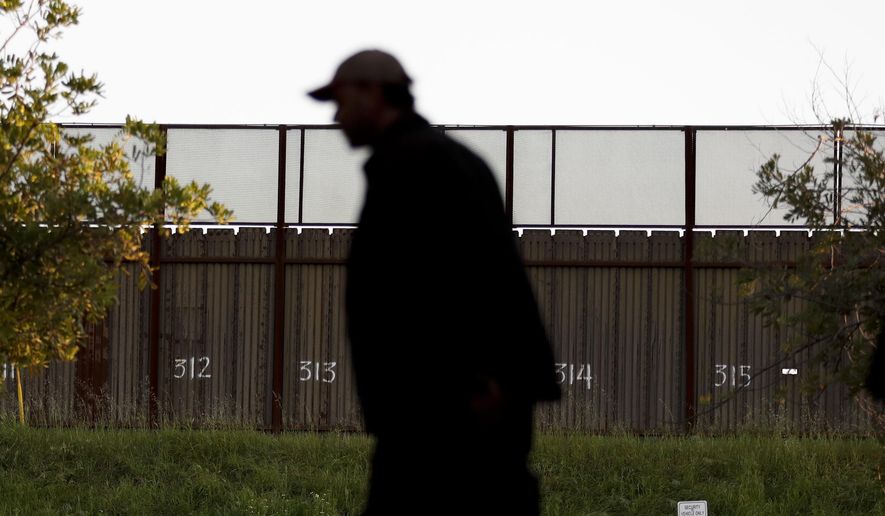The first leg of President Trump’s planned border wall will cost an exorbitant $24.5 million per mile, according to the 2018 budget he submitted Tuesday that details a massive shake-up in immigration policy.
Mr. Trump calls for a giant increase in detention beds to help end the catch-and-release policies of previous administrations, requests major infusions of cash for more border and interior agents to apprehend illegal immigrants, and proposes more prosecutors and judges to speed their cases along.
Also on tap is a boost in funding for E-Verify, the government’s voluntary system that allows businesses to check potential hires’ legal status. Mr. Trump says he wants the system to be mandatory for all U.S. businesses in three years.
But Mr. Trump has his eye on something even bigger, signaling that he wants to try to shift the country’s immigration system from one in which immigrants pick the U.S. to one in which the U.S. picks immigrants based on who can best help the country, without becoming a drain on public finances.
In his proposed budget, Mr. Trump says he is looking for ways to calculate the “net budgetary effects” of immigration programs and policy.
“Once the net effect of immigration on the federal budget is more clearly illustrated, the American public can be better informed about options for improving policy outcomes and saving taxpayer resources,” the president said in the blueprint. “In that regard, the budget supports reforming the U.S. immigration system to encourage: merit-based admissions for legal immigrants, ending the entry of illegal immigrants, and a substantial reduction in refugees slotted for domestic resettlement.”
Trump officials said the more refugees the U.S. accepts, the less money there is to help them — so taking fewer people means being able to do more for those who are accepted.
It’s one of a series of proposals that mark a major break with the Obama administration’s more lax approach to immigration enforcement.
It’s unclear how much of Mr. Trump’s budget will get through Congress overall, much less his plans for the Homeland Security Department.
He has asked for a major increase in detention beds, to more than 51,000. Under the Obama administration, the level hovered at about 34,000, though it has risen to 39,000 this year.
Homeland Security officials said having the space to hold illegal immigrants has been critical to reducing the number of illegal crossings so far under the Trump administration. If illegal immigrants know they will be detained and then deported, rather than released into the community, then they are less likely to attempt the crossing, said acting Customs and Border Protection Deputy Commissioner Ronald D. Vitiello.
“If there’s a consequence applied to illegal activity, you get less of that activity,” he testified to the Senate Judiciary Committee.
Immigrant rights groups were furious at the budget, saying it amounts to a massive enforcement operation that will feed the private prison industry, which runs many of the detention centers, at the expense of rights of Americans and illegal immigrants.
Most galling to the groups was a change to the law slipped into a 1,200-page budget document that would force state and local police to hold illegal immigrants up to 48 hours beyond their regular release point if federal agents issue a request.
That change is meant to crack down on so-called sanctuary jurisdictions that refuse cooperation.
Under the proposal, states would either have to promise to comply or risk losing an expanded pool of federal money.
Asked about the reasons for burying the proposal inside the massive budget document, Homeland Security spokesman David Lapan demurred.
“We’ll have to check with the lawyers,” he told reporters being briefed on the budget.
Homeland Security officials said they didn’t have a cost figure for the total border wall as envisioned by Mr. Trump, but gave estimates for several initial legs.
Some 32 miles of new wall will be built in the Border Patrol’s Rio Grande Valley sector at a price of $784 million, or $24.5 million per mile.
That is four times the $6 million Homeland Security paid per mile for recent upgrades to fencing in Nogales, Arizona, and it’s six times the cost of upgrading 9 miles of fence near Douglas, Arizona.
The department did not explain the massive spike in cost per mile.
Mr. Trump’s budget also calls for 28 miles of levee wall to be built along the Rio Grande at a total cost of $498.4 million and 14 miles of replacement wall to be erected near San Diego at $250.6 million.
Mr. Lapan said the wall is an “iterative, incremental process,” with the department focusing on the areas with the most pressing need and asking for that funding right now.
He did confirm that the department is not looking to build a wall across the entire southwestern border, as candidate Trump had suggested. Mr. Lapan said there are some areas where the terrain won’t allow for a wall.
Groups pushing for a stiffer immigration stance said they were disappointed that Mr. Trump appears to be backing off his campaign pledge.
“After yielding to Democratic obstructionists on funding for the fence in order to ensure passage of the omnibus spending bill earlier this month, the president implied that he would fight to ensure that adequate funding was included in the FY 2018 budget. Nothing in this budget proposal suggests that he is fighting very hard,” said Dan Stein, president of the Federation for American Immigration Reform.
• Stephen Dinan can be reached at sdinan@washingtontimes.com.




Please read our comment policy before commenting.